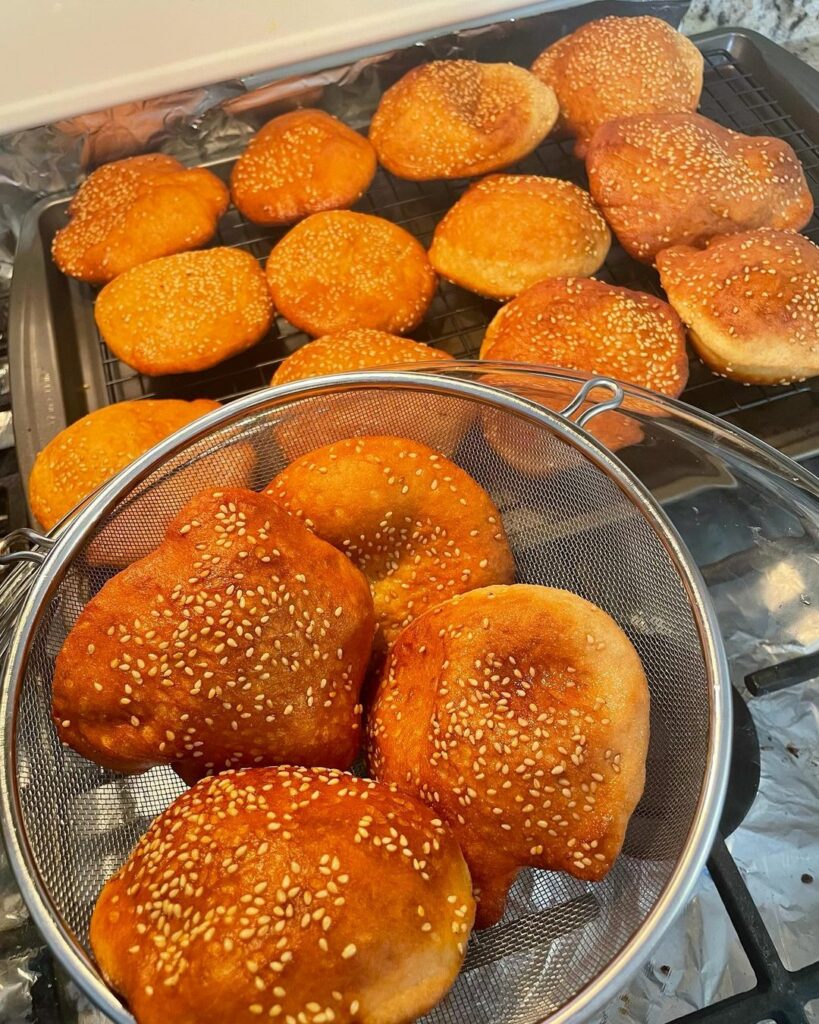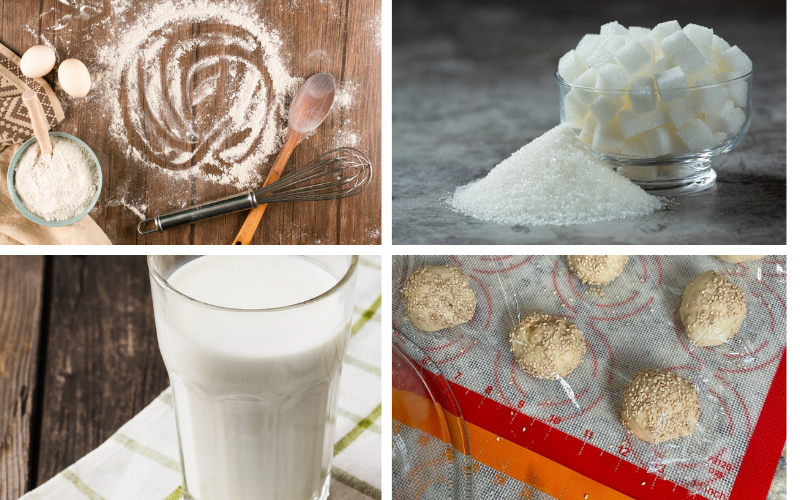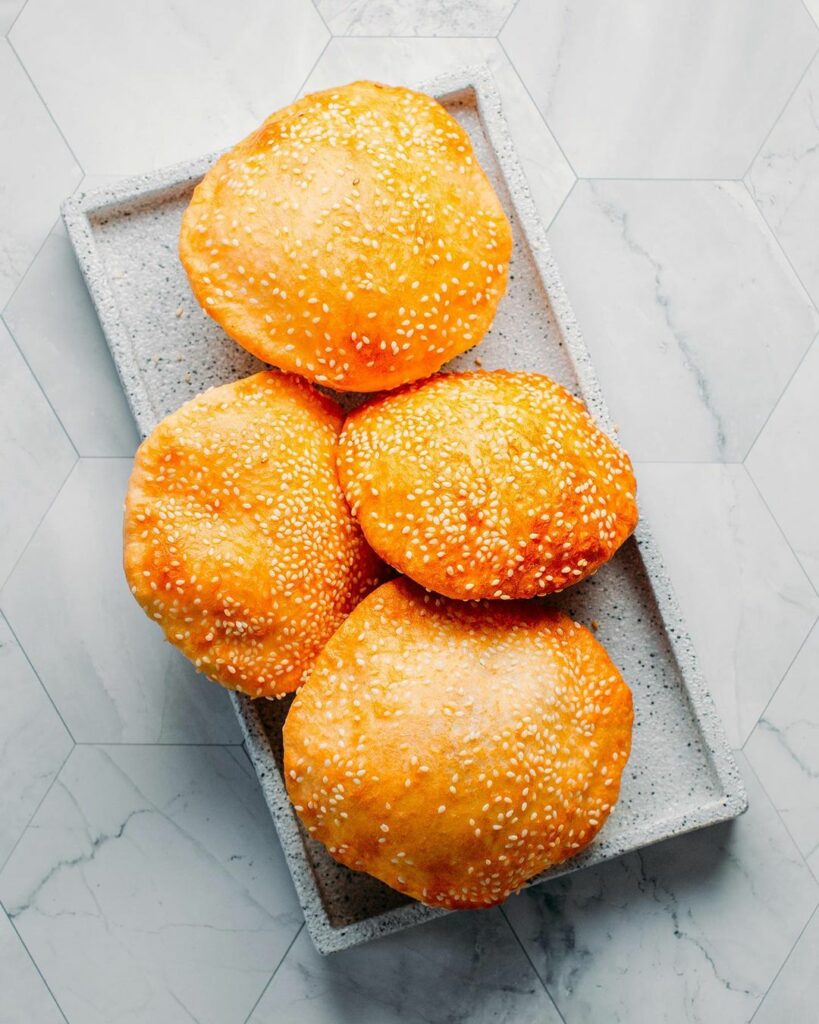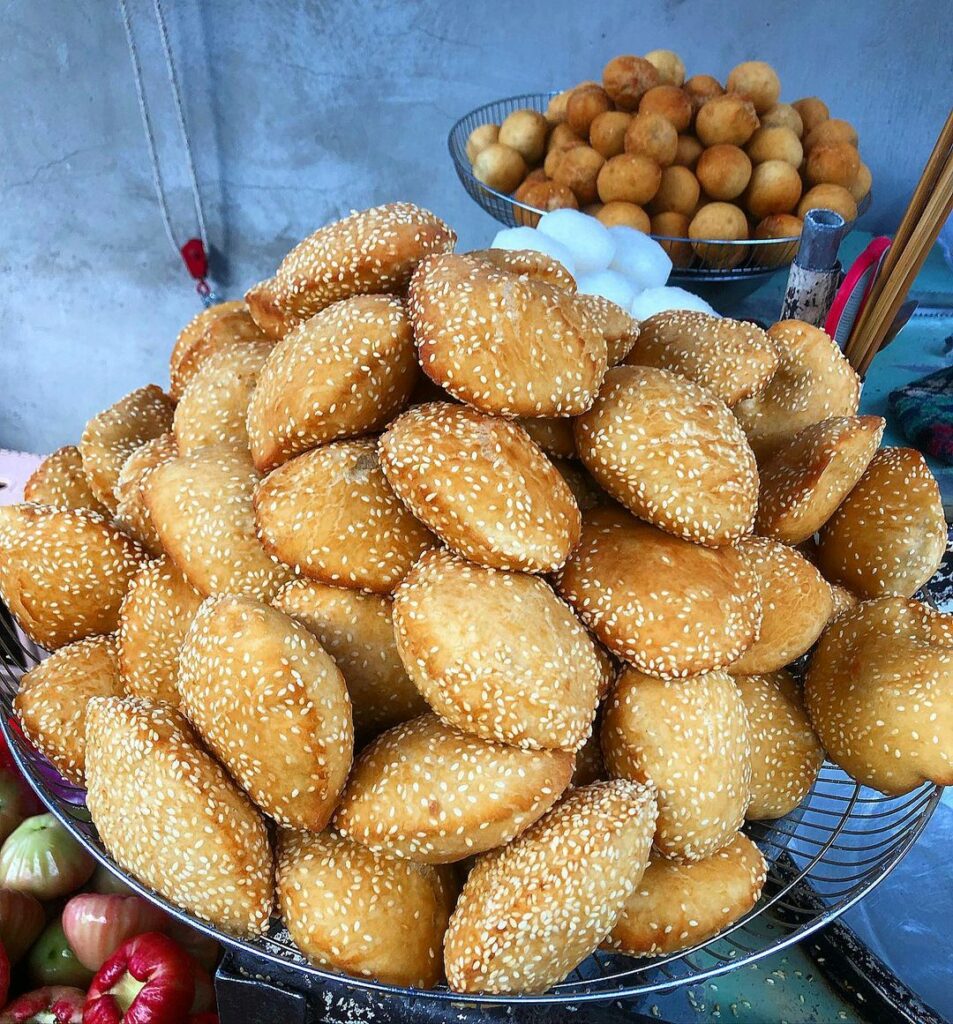As someone who has a deep appreciation for Vietnamese cuisine, I have been fortunate enough to try many traditional dishes. Among them, banh tieu stands out as a personal favorite. These delightful treats are often referred to as “Vietnamese donuts” due to their round shape and hollow center.
However, unlike regular donuts, banh tieu are incredibly tender and coated with crispy sesame seeds. With every bite, you get a perfect balance of sweetness and savory flavor, making them an ideal snack any time of day. In this article, we will delve into everything you need to know about banh tieu, from its history and cultural significance to the different variations and health benefits. So, settle in with a cup of coffee and get ready to discover the world of banh tieu!
What is banh tieu?

Banh tieu is one of the traditional list of Vietnamese desserts you must try, it has a unique flavor and texture that sets it apart from the traditional American donut. banh tieu is made from a combination of flour, sugar, yeast, and oil, and is coated with sesame seeds, which gives it a crunchy outside.
Banh tieu is a traditional Vietnamese pastry that is often compared to Chinese youtiao crullers. In Vietnam, banh tieu is commonly enjoyed as a convenient street food snack and is best served warm and freshly prepared.
Vietnamese donut is often served as a dessert, alongside a cup of tea or coffee, soy milk, but can also be served as a savory snack, stuffed with various fillings. Banh tieu has a unique texture and flavor that have made it a beloved pastry not only in Vietnam but around the world.
Vietnamese banh tieu recipe

To make banh tieu, a popular Vietnamese donut, mix flour, sugar, yeast, salt, and warm water to form a dough. Rest the dough for an hour and add baking powder before frying. Dip the flattened discs in sesame seeds and fry them in hot oil until golden brown and crispy. Let them cool before serving.
Cooking note
- Yield: 10-12 banh tieu.
- Prep time: 15 minutes
- Cook time: 10 minutes
- Resting time: 1 hour 30 minutes
- Total time: 1 hour 55 minutes
- Course: Dessert/snack
- Cuisine: Vietnamese
Banh tieu ingredients
- 2 cups of all-purpose flour
- 1/4 cup of granulated sugar
- 1 1/2 teaspoons of dry yeast
- 1/4 teaspoon of salt
- 1/2 cup of lukewarm water
- 1/4 teaspoon of baking powder
- 1/4 cup of sesame seeds
- Vegetable oil for frying
- 1/4 cup of milk
Note that these quantities are an estimate, and you may need to adjust them depending on the size of your banh tieu and your desired level of sweetness or saltiness.
How to make banh tieu?
To make banh tieu, let follow these step-by-step instructions:
- In a large mixing bowl, whisk together the flour, sugar, dry yeast, salt, and baking powder.
- In a separate bowl, combine the lukewarm water and milk. Then, add the liquid mixture to the dry ingredients and stir until a dough forms.
- Knead the dough on a floured surface until it becomes smooth and elastic.
- Cover the dough with a damp cloth and let it rise for 1–2 hours until it doubles in size.
- Divide the dough into small pieces and roll each ball in white sesame seeds until coated.
- Flatten each piece with a rolling pin until they are about 1/4 inch thick.
- Heat vegetable oil in a deep fryer or large pot until it reaches 350 °F.
- Carefully place the banh tieu in the hot oil and fry until they are golden brown, about 3–4 minutes per side.
- Remove the banh tieu from the oil and let them cool on a wire rack.
Note: You can add vanilla extract to add flavorings to banh tieu dough.
Tips for perfecting your banh tieu

Here are some additional tips to help you perfect your banh tieu:
- Use fresh yeast: Using fresh yeast will give you better results than using old or expired yeast. Make sure to check the expiration date on the yeast packet before using it.
- Don’t over-flour the surface: When rolling out the dough, make sure not to use too much flour on the surface. This can cause the banh tieu to become too dry and tough.
- Use the right amount of oil: When frying the banh tieu, make sure to use enough oil to fully submerge them. If the oil level is too low, the banh tieu will not cook evenly.
- Use a thermometer: To ensure that the oil is at the right temperature, use a thermometer to check the temperature of the oil before frying.
- Drain excess oil: After removing the banh tieu from the oil, place them on a wire rack or paper towel to drain the excess oil. This will help keep the banh tieu crispy and prevent them from becoming too oily.
- Experiment with fillings: While traditional banh tieu are usually plain, you can experiment with different fillings to add more flavor and texture. Try filling them with chocolate, cheese, or savory meats for a unique twist on this classic pastry.
Health benefits of Vietnamese donut
Here is a table showing the nutritional information and health benefits of Vietnamese donuts:
| Nutrient | Amount |
| Calories | 120 |
| Total Fat | 5g |
| Saturated Fat | 1g |
| Cholesterol | 0mg |
| Sodium | 70mg |
| Total Carbohydrates | 17g |
| Dietary Fiber | 1g |
| Sugars | 5g |
| Protein | 2g |
Note: banh tieu should be consumed in moderation due to its high sugar and fat content.
Variations of banh tieu

Depending on the preferences of the baker, the shape and size of the cake will vary. Some banh tieu are elongated, or others can be round, even heart-shaped. In addition, the size of banh tieu can be from small to larger than the palm of your hand.
Bánh tiêu sầu riêng (banh tieu with durian)
This variation is made by adding mashed durian fruit to the dough before frying, giving the banh tieu a unique and fruity flavor.
Bánh tiêu lá dứa (banh tieu panda leave)
This variation uses additional pandan leaves in the dough, giving the pastry a green hue and infusing it with a subtle, fragrant aroma. The pandan leaves also add a slightly sweet, herbal taste to the banh tieu.
Bánh tiêu đậu xanh (banh tieu green bean)
This variation is made by adding mashed mung beans to the dough before frying, resulting in a banh tieu with a slightly sweet and nutty flavor.
Bánh tiêu kẹp bánh bò
This variation is made by sandwiching a piece of banh bo between two pieces of banh tieu. The combination of the airy and soft, chewy creates a unique and satisfying texture.
Serving and Pairing Vietnamese donut
Banh tieu, the delicious Vietnamese pastry, can be enjoyed in various ways, and it pairs well with many different foods and beverages. Here are some popular serving and pairing options:
Popular ways to serve banh tieu:
- Plain banh tieu is a popular snack on its own and is best enjoyed warm and freshly prepared.
- Banh tieu can also be served with a sweetened condensed milk dip or drizzled with honey, and coconut milk for added sweetness.
Pairing banh tieu with other foods:
- Banh tieu can be paired with chocolate, either as a filling or a dip, for a deliciously decadent treat.
- Peanut butter is another great option for pairing with banh tieu, as the nuttiness of the peanut butter complements the pastry’s sweetness.
- Banh tieu can also be served with fresh fruit, such as strawberries or mango, for a light and refreshing pairing.
Beverages to pair with banh tieu:
- Vietnamese iced coffee, also known as Ca Phe Sua Da, is a popular beverage to pair with banh tieu.The sweet and strong coffee flavor complements the pastry’s sweetness.
- Tea, especially green tea, jasmine tea, or you can even drink artichoke tea, is another great option for pairing with banh tieu. The tea’s subtle and delicate flavors complement the pastry’s aromatic taste.
- For a non-alcoholic beverage, soda or sparkling water can provide a refreshing contrast to the pastry’s sweetness.
Where to eat banh tieu?
If you’re looking for a place to try banh tieu, there are many options in Westminster, California. Here are some popular places to eat banh tieu:
- Banh Mi & Che Cali Bakery: This popular bakery chain serves a range of Vietnamese pastries, including delicious banh tieu.
- Banh Mi So 1: This restaurant is known for its delicious Banh Mi sandwiches, but it also serves a range of other Vietnamese specialties, including banh tieu.
- Kang Lac Bakery: This family-owned bakery is a popular spot for traditional Vietnamese pastries, including banh tieu.
FAQs
What is the best way to store banh tieu?
To maintain the freshness and texture of banh tieu, it’s important to store them properly. Here are some tips for storing banh tieu:
- Allow the banh tieu to cool completely before storing them. This will prevent moisture from accumulating in the container.
- Store the banh tieu in an airtight container or a plastic bag. This will help to keep them fresh and prevent them from drying out.
- Keep the banh tieu at room temperature or in a cool, dry place. Avoid storing them in the fridge as this can cause them to become hard and dry.
How to preserve banh tieu dough?
To preserve banh tieu dough, you can follow these steps:
- Place the bowl of dough in the refrigerator and let it rest for up to 24 hours. This will allow the dough to develop its flavor and texture.
- When you’re ready to use the dough, remove it from the refrigerator and let it come to room temperature for about an hour.
How long does banh tieu last?
The shelf life of banh tieu depends on how they are stored. If stored properly, banh tieu can last for up to 2-3 days at room temperature. However, they are best enjoyed when they are fresh and warm.
Be sure to wrap them tightly in plastic wrap or place them in an airtight container before freezing. When you’re ready to eat them, let them thaw at room temperature for a few hours before reheating.
Is banh tieu gluten-free?
No, banh tieu is not gluten-free as it is made with wheat flour which contains gluten. If you have a gluten intolerance or celiac disease, you should avoid consuming banh tieu. However, there are some gluten-free alternatives that can be used to make a similar type of pastry, such as using rice flour or other gluten-free flours.
If you’re looking for a gluten-free option, it’s best to check with the restaurant or bakery before consuming banh tieu to ensure that it does not contain any gluten-based ingredients.
Can I make banh tieu dough without yeast?
Yes, you can make banh tieu dough without yeast by using baking powder as a leavening agent. To make banh tieu dough without yeast, simply combine the dry ingredients (flour, sugar, salt, and baking powder) in a bowl.
Can I fry banh tieu without oil?
It is not recommended to fry banh tieu without oil as this will affect the texture and flavor of the pastry. Deep-frying banh tieu in oil is essential to achieve the crispy and golden brown exterior.
Without the oil, the pastry will not have the same texture and will not cook evenly. Additionally, the sesame seeds coating the pastry will not stick to the dough properly without oil. So, it is not recommended to fry banh tieu without oil.
What is the difference between banh tieu and banh Cam?
banh tieu and Banh Cam are two popular Vietnamese pastries, but they have some key differences in their ingredients and preparation.
- Banh tieu is a hollow pastry made from a dough that is typically made with wheat flour, sugar, yeast, and water. The dough is shaped into small balls, rolled in sesame seeds, and then deep-fried until crispy and golden brown. Banh tieu is usually served plain or with a sweetened condensed milk dip.
- Banh Cam, on the other hand, is a round pastry that is filled with sweet mung bean paste and coated with sesame seeds. The pastry is made from glutinous rice flour, sugar, sesame seeds, and water. The filling is made from cooked mung beans that are mashed and sweetened with sugar. The pastry is then shaped into small balls, filled with the mung bean paste, and deep-fried until crispy and golden brown.
So, the main difference between banh tieu and banh cam is the filling. Banh tieu is a hollow pastry with no filling, while banh cam is filled with sweet mung bean paste. Additionally, banh tieu is made with wheat flour, while banh cam is made with glutinous rice flour.
Conclusion
Bluntly stated banh tieu is a beloved Vietnamese pastry that has a rich history and cultural significance. It’s crispy texture and fragrant aroma make it a popular snack and dessert, enjoyed by people of all ages in Vietnam and beyond.
Banh tieu is also a versatile pastry that can be paired with a variety of foods and beverages. While it is traditionally made with wheat flour, there are variations that use different ingredients and flavors to create unique twists on the classic pastry.
As banh tieu continues to gain popularity in other parts of the world, it remains an important part of Vietnamese cuisine and culture. Whether enjoyed on the streets of Vietnam or at a Vietnamese bakery abroad, banh tieu is a delicious and satisfying pastry that is sure to please.
More Vietnamese desserts you can try at home: